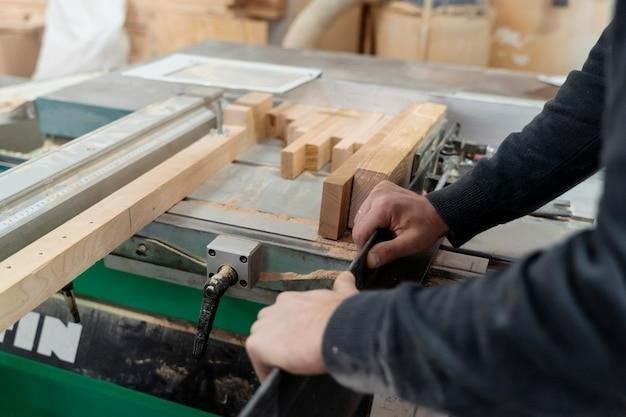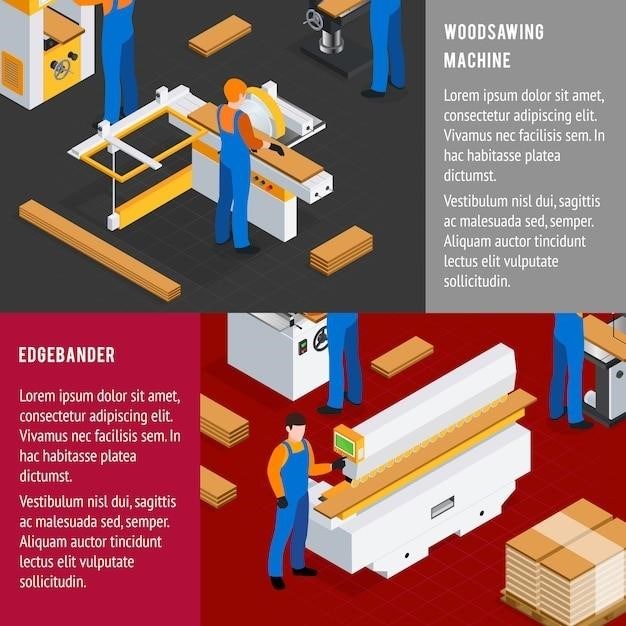
Choosing the Right Table Saw Fence System
Selecting the ideal table saw fence system hinges on accuracy needs‚ budget‚ and saw type. Consider aftermarket options for enhanced precision beyond OEM fences. Complete systems offer precise fits and easy part replacement‚ while add-ons like digital readouts boost accuracy. Choose wisely for optimal performance and safety.
Understanding Table Saw Fence Accuracy
The accuracy of your table saw fence is paramount for precise cuts. A misaligned fence leads to inaccurate cuts‚ potentially resulting in wasted materials and frustrating rework. Factors influencing accuracy include the fence’s construction‚ its alignment with the blade‚ and the precision of its adjustment mechanisms. High-end fences often boast accuracy within 0.002 inches‚ while others might only reach 1/64th of an inch. Consider the level of accuracy you need for your projects—intricate joinery demands higher precision than rough cuts. Regular calibration and maintenance are essential to ensure sustained accuracy. A digital readout can significantly enhance precision‚ eliminating the guesswork of manual measurement. When assessing the accuracy of your system‚ remember that even minor misalignments can accumulate‚ leading to noticeable errors over time. Prioritize a fence with robust construction and smooth‚ precise adjustment for optimal results.
Types of Table Saw Fences⁚ Aftermarket vs. OEM
Table saw fences are broadly categorized into Original Equipment Manufacturer (OEM) and aftermarket varieties. OEM fences are those included with the saw purchase‚ offering basic functionality. Their accuracy and durability often vary depending on the saw’s overall quality and price point. Aftermarket fences‚ conversely‚ present a wide array of options to upgrade your saw’s capabilities. These range from simple improvements to the existing fence to completely new systems with advanced features. Aftermarket choices frequently provide superior accuracy‚ smoother operation‚ and enhanced adjustability compared to their OEM counterparts. Complete aftermarket systems‚ such as the Shop Fox W1716‚ offer improved fit and wear and tear replacement sections. The choice depends on your budget and desired level of precision; upgrading can significantly improve cut quality and overall woodworking experience. Consider factors like materials‚ build quality‚ and ease of use when choosing between OEM and aftermarket options. Remember to check compatibility with your specific table saw model before purchasing.
Factors Affecting Cut Accuracy⁚ Blade Alignment and Miter Slots
Achieving precise cuts on a table saw demands meticulous attention to blade alignment and miter slot integrity. A blade misaligned relative to the miter slots introduces inaccuracies‚ leading to skewed cuts and compromised workpiece integrity. Regular checks using a dial indicator are crucial for maintaining parallel alignment between the blade and miter slots; aiming for discrepancies within 0.002 inches is ideal. Worn or damaged miter slots similarly impact accuracy. These slots guide the miter gauge and fence‚ ensuring the workpiece’s consistent positioning relative to the blade. Deformations in the slots can cause binding‚ inaccurate cuts‚ and even safety hazards. Inspecting the miter slots for damage and ensuring smooth operation is essential. Furthermore‚ the blade itself must be properly aligned perpendicular to the table surface. Any tilt or deviation will result in uneven cuts. Regular calibration and maintenance are vital in minimizing these factors’ impact on cut accuracy. Prioritize these elements to ensure the production of consistently precise and safe cuts.
Improving Table Saw Fence Precision
Enhance table saw fence accuracy through calibration‚ alignment adjustments‚ and incorporating digital readouts. These upgrades minimize discrepancies‚ ensuring precise cuts and repeatable results for various woodworking tasks. Regular maintenance is crucial for sustained precision.
Digital Readouts for Enhanced Accuracy
Digital readouts significantly elevate the precision of your table saw fence system. Unlike traditional ruler scales‚ which are prone to inaccuracies due to parallax and wear‚ digital readouts provide clear‚ precise measurements‚ eliminating guesswork and ensuring consistent results. These add-ons typically display the distance between the fence and the blade with high accuracy‚ often to thousandths of an inch. This eliminates the need for manual measurement and drastically reduces errors in setting the fence for repetitive cuts. The Wixey Digital Fence Readout Kit‚ for instance‚ is a popular universal option compatible with various table saw models. Investing in a digital readout is a worthwhile upgrade for woodworkers who demand accuracy and efficiency in their projects‚ especially when working with intricate designs or requiring precise repeatability. The time saved alone often justifies the cost‚ streamlining your workflow and improving the overall quality of your work.
Adjusting and Aligning Your Fence
Precise alignment of your table saw fence is paramount for accurate cuts. Begin by ensuring the blade is perfectly perpendicular to the miter slots. Use a dial indicator to measure any discrepancies‚ aiming for an alignment within 0.002 inches. Next‚ align the fence parallel to the blade. Various methods exist‚ including using a straight edge and feeler gauges to measure the distance between the fence and the blade at multiple points along its length. Adjust the fence’s alignment screws until the distance is consistent across the entire length. Remember‚ a misaligned fence leads to inaccurate cuts‚ potentially damaging your workpiece and even causing safety hazards. Regularly check and readjust your fence alignment to maintain precision. For optimal results‚ consult your table saw’s manual for specific adjustment procedures and recommended tolerances. Maintaining proper alignment is crucial for both the accuracy and safety of your woodworking operations.
Calibration Techniques for Precise Cuts
Achieving precise cuts with your table saw requires meticulous calibration of the fence. One effective method involves cutting a test piece at a specific measurement‚ then measuring the resulting cut. Any discrepancy reveals the error in the fence’s setting. Adjust the fence accordingly and repeat the process until the measured cut matches the intended measurement. For enhanced accuracy‚ use a digital fence readout system. These systems eliminate the need for manual measurements‚ providing immediate feedback and reducing human error. Alternatively‚ you can create a calibration jig using precisely measured pieces of material. This jig serves as a reference point for setting the fence‚ ensuring repeatable accuracy over time. Remember‚ consistent calibration is key for maintaining precision. Regularly check your fence’s alignment and calibration to ensure accurate cuts and avoid wasting materials. Paying attention to these details will significantly improve your woodworking results and overall efficiency. Always refer to your saw’s manual for specific calibration instructions.

Advanced Table Saw Fence Systems
High-end systems like the Incra LS offer unparalleled accuracy and repeatability‚ utilizing patented lead screw technology for precise positioning. These systems justify their cost through enhanced precision and time savings for intricate woodworking projects.
Incra LS Fence Positioning System⁚ Features and Benefits
The Incra LS Fence Positioning System stands out for its exceptional accuracy and repeatability‚ features highly praised by woodworking enthusiasts. Its patented lead screw technology allows for incredibly precise positioning of your workpiece‚ eliminating the guesswork and frustration often associated with traditional fence systems. This translates to cleaner‚ more accurate cuts every time‚ crucial for intricate projects demanding high precision. The system’s ease of use is another significant advantage. Even those new to woodworking can quickly master its operation‚ thanks to its intuitive design and clear instructions. The Incra LS system’s ability to quickly return to previously used positions is a huge time-saver‚ especially when making multiple identical cuts. This repeatability feature ensures consistent results‚ minimizing waste and maximizing efficiency. While the Incra LS represents a higher initial investment compared to basic fences‚ its precision‚ durability‚ and time-saving capabilities make it a worthwhile choice for serious woodworkers who value accuracy and efficiency.
High-End Fence Systems⁚ Precision and Repeatability
Investing in a high-end table saw fence system offers significant advantages for precision woodworking. These systems often incorporate features like micro-adjustments‚ allowing for incredibly fine control over fence positioning. This level of precision is invaluable for tasks requiring exact measurements and repeatability‚ such as creating multiple identical pieces or working with complex joinery. High-end fences are typically constructed from durable materials‚ ensuring longevity and resistance to wear and tear. The smooth gliding action of these fences contributes to a more effortless cutting experience‚ reducing friction and potential binding. Many premium models incorporate features designed to enhance accuracy and consistency. Digital readouts provide clear visual feedback on fence position‚ eliminating the need for manual measurement and reducing potential errors. Some high-end systems include features that aid in aligning the fence perfectly parallel to the saw blade‚ a critical factor in achieving straight‚ accurate cuts; While the initial cost of a high-end fence is greater than basic models‚ the enhanced accuracy‚ durability‚ and efficiency they provide often justify the investment for professional woodworkers and serious hobbyists.
Choosing a Fence Based on Your Needs and Budget
Selecting a table saw fence requires careful consideration of your woodworking needs and budget. Begin by assessing the precision required for your projects. For occasional hobbyists‚ a basic‚ affordable fence might suffice. However‚ professionals or those undertaking intricate projects will benefit from a high-end system offering superior accuracy and repeatability. Consider the size of your workpiece; larger pieces demand a longer fence. Evaluate the build quality and materials; durable‚ robust fences minimize wear and tear‚ extending their lifespan. Ease of use is critical; a user-friendly fence simplifies setup and adjustments‚ saving valuable time. Compatibility with your existing table saw is also essential; ensure the chosen fence fits securely and functions correctly. Finally‚ while price is a factor‚ avoid sacrificing quality for cost savings‚ especially if you prioritize precision and long-term use. Research reviews and compare features to make an informed decision based on your specific needs and budget constraints. Remember‚ a well-chosen fence significantly impacts the accuracy and efficiency of your woodworking.

Maintaining Your Table Saw Fence
Regular maintenance ensures optimal performance and prolongs the life of your table saw fence. Clean debris‚ lubricate moving parts‚ and check for alignment issues. Address any problems promptly to prevent costly repairs and ensure safe operation.
Regular Maintenance for Optimal Performance
Maintaining your table saw fence involves consistent cleaning and lubrication. Regularly remove sawdust and wood chips from the fence‚ rails‚ and any moving parts. Compressed air is excellent for this task‚ ensuring thorough cleaning. A light application of high-quality lubricant‚ such as a silicone-based spray‚ to the moving parts promotes smooth operation and prevents binding. Avoid using excessive lubricant‚ as this can attract more debris. Inspect the fence for any signs of wear or damage‚ such as loose screws‚ dents‚ or scratches. Tighten any loose screws to ensure stability and prevent inaccuracies. Consider replacing damaged or excessively worn parts to maintain accuracy and prevent safety hazards. Periodically check the fence’s alignment with the saw blade‚ using a measuring device to ensure perfect parallelism. A perfectly aligned fence is crucial for precise cuts and prevents dangerous kickbacks. By following these maintenance practices‚ your table saw fence will continue to deliver consistently accurate results for years to come.
Troubleshooting Common Fence Issues
Addressing common table saw fence problems ensures smooth operation and accurate cuts. If the fence binds or moves unevenly‚ check for sawdust buildup on the rails and moving parts. Clean thoroughly using compressed air or a brush. If the problem persists‚ lubricate the rails sparingly with a suitable lubricant. A misaligned fence leads to inaccurate cuts. Use a measuring device to check the fence’s parallelism to the blade and adjust accordingly. Refer to your saw’s manual for specific alignment instructions. If the fence is loose or wobbly‚ tighten all screws to secure it firmly. Loose screws can cause inaccurate cuts and pose safety risks. Damaged fence components‚ like bent rails or cracked parts‚ require repair or replacement. Inspect the fence thoroughly for any damage and repair or replace damaged parts as needed. If the fence’s locking mechanism malfunctions‚ check for obstructions or damage. Clean the mechanism and lubricate if necessary. If the issue continues‚ consult your saw’s manual or a qualified technician. Regular maintenance and prompt attention to these common problems will keep your table saw operating safely and efficiently.
Safety Precautions When Using a Table Saw Fence
Prioritize safety when using a table saw fence. Always ensure the fence is securely attached and properly aligned to the blade before starting any operation. Never operate the saw with a damaged or malfunctioning fence. Inspect the fence thoroughly before each use for any signs of wear or damage. Replace or repair any damaged parts immediately. Use push sticks or featherboards to safely guide the workpiece through the blade‚ especially when cutting small pieces. Avoid reaching over the blade while the saw is running. Always use appropriate personal protective equipment (PPE)‚ including eye protection‚ hearing protection‚ and dust masks. Keep your hands and fingers clear of the blade and moving parts. Never force the workpiece into the blade. Allow the blade to do the work. Maintain a firm grip on the workpiece throughout the cutting process. Be aware of kickback risks. Position yourself appropriately to avoid being struck by the workpiece if it gets ejected from the blade. Before making any adjustments to the fence‚ always turn off and unplug the saw. Ensure the blade is completely stopped before making any adjustments. Regularly clean the fence and its surrounding area from sawdust to prevent obstructions and ensure smooth operation. Properly dispose of any wood scraps and sawdust safely. Follow the manufacturer’s instructions carefully for safe operation of your specific table saw model.